
Maoricrambus is a genus of moths of the family Crambidae. It contains only one species, Maoricrambus oncobolus, which is endemic to New Zealand. This species is classified as Nationally Endangered by the Department of Conservation.

Heterocrossa gonosemana is a species of moth in the family Carposinidae. It is endemic to New Zealand.

Circoxena ditrocha is a species of moth in the family Blastodacnidae. This species is endemic to New Zealand and has been collected on both the North and South Islands. The habitat of this species is on the edges of native forest or scrub and it may be associated withPseudopanax arboreus. As at 2000 the host species of this moth is unknown but it has been hypothesised that the larvae are seed borers. Adults are on the wing in December to March. It is classified as "At Risk, Naturally Uncommon" by the Department of Conservation.
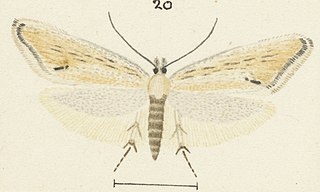
Glyphipterix necopina is a species of sedge moth in the genus Glyphipterix. It is endemic to New Zealand. It is classified as Not Threatened by the Department of Conservation.
Phaeosaces lindsayae is a species of moth in the family Depressariidae. It is endemic to New Zealand. It is classified as "Data Deficient" by the Department of Conservation.
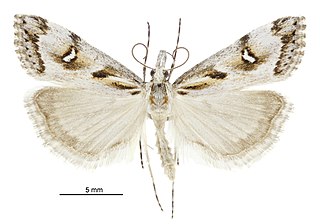
Gadira leucophthalma, the beaked moss moth, is a moth in the family Crambidae. It is endemic to New Zealand. It is found in the south eastern side of the South Island down to Banks Peninsula. G. leucophthalma inhabits the foredunes of coastal areas. The larval host is unknown but it has been hypothesised that the larvae feed on moss. The adult moths are day flying although some specimens have been trapped at night via light traps. Adults are commonly on the wing from March to April. This species has been classified as Nationally Vulnerable by the Department of Conservation.

Orocrambus abditus is a moth of the family Crambidae. It was first described by Alfred Philpott in 1924. It is endemic to New Zealand and can be found in Marlborough, Arthur's Pass, and in Canterbury. The species inhabits grassland including tussock grassland and shrubland. Larvae have been collected in October and the adults of this species are on the wing from October to March.
Orocrambus punctellus is a species of moth in the family Crambidae. It is endemic to New Zealand. It is classified as "Data Deficient" by the Department of Conservation.
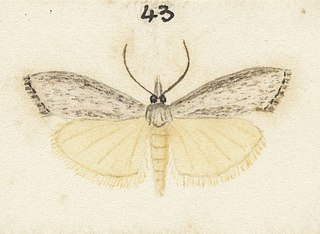
Orocrambus sophronellus is a moth in the family Crambidae. This species is endemic to New Zealand. This species has been classified as Data Deficient by the Department of Conservation.

Anisoplaca fraxinea is a species of moth of the family Gelechiidae. It was described by Alfred Philpott in 1928 and is endemic to New Zealand. It has been observed in the South Island and adults are on the wing in February and March.

Eutorna inornata is a moth in the family Depressariidae. It was described by Alfred Philpott in 1927. It is endemic to New Zealand and has been observed in both the North and South Islands. The larvae of this moth are leaf minors of Selliera radicans.

Pseudocoremia fluminea is a species of moth in the family Geometridae. It is endemic to New Zealand. It is classified as Not Threatened by the Department of Conservation.

Orocrambus sophistes is a moth in the family Crambidae. This species is endemic to New Zealand and has been observed in South Island at the Mackenzie Basin, Central Otago and Otago Lakes areas. This moth is a dryland specialist and inhabits short tussock grasslands. The larval host species is Festuca novae-zelandiae. The adults of this species have been observed from mid January to April with the female being flightless. The adult male is attracted to light. This species has been classified as Nationally Vulnerable by the Department of Conservation.
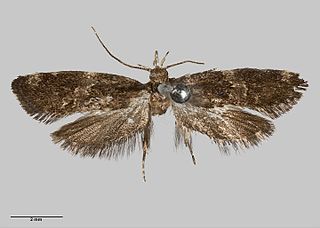
Trachypepla nimbosa is a species of moth in the family Oecophoridae. It is endemic to New Zealand. This species has been collected in Auckland as well as one specimen in the West Coast. Adults are on the wing in January however the West Coast specimen was collected in November. This species is classified as "Data Deficient" by the Department of Conservation.
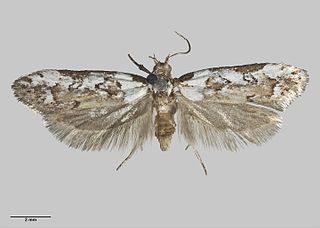
Trachypepla festiva is a moth of the family Oecophoridae and was first described by Alfred Philpott in 1930. It is endemic to New Zealand and has been collected in the northern parts of the North Island.
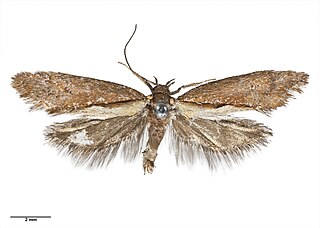
Tingena laudata is a species of moth in the family Oecophoridae. It is endemic to New Zealand and has been observed in Fiordland and Otago. Adults of this species are on the wing in January.

Tingena morosa is a species of moth in the family Oecophoridae. It is endemic to New Zealand and has been found in the South Island in Nelson including at the Dun Mountain and in the Canterbury region. This species inhabits native forest at altitudes from 2000 to 3000 ft. Adults of this species are on the wing in December.

Tingena vestita is a species of moth in the family Oecophoridae. It is endemic to New Zealand and has been collected in Fiordland. The adults of this species are on the wing in January.

Meterana badia is a species of moth in the family Noctuidae. This species is endemic to New Zealand.
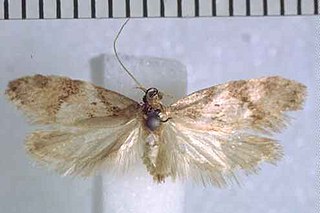
Trachypepla angularis is a species of moth in the family Oecophoridae. It is endemic to New Zealand and has been collected at Lake Rotoroa in the Nelson Lakes National Park in January. This species inhabits mixed native forest.



















